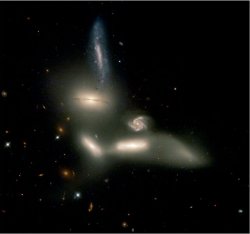Originally posted by Kethoticus
You saw the Milky Way. Since that's the edge of our galaxy, something we normally see very bright in long-exposure photos, you get an idea of why I say that we wouldn't see the galaxy collision much more brightly. Did you know that there are colorful nebulae in our sky that are actually quite large, but that we barely see, if at all, because of the fact that these objects are normally very dim to the naked eye?
Ok, I don't think you understood me then. I know I saw the Milky Way - I'm an amature astromoner of sorts - most of the space/astromony current events my threads. The Orion Nebula, just below the belt of Orion is a classic example of what you're talking about. You can't see it with the naked eye, but its there and actually takes up quite a large bit of sky.
The Andromeda Galaxy is also very large, with an angular footprint several times larger than the full moon, yet its not something you see - for one reason its so far away.
In the case of these colliding galaxies, all within a relatively small part of space, there would be a lot more stars visible to the naked eye. If you look up at the Milkyway you see a band of light that marches across the sky (why do you think its called that anyway?) In Alaska it was some much more pronounced to the point that even if it didn't glow, the ambient light of the space surrounding any star in the Milkyway was effectively brighter than one not in the Milkyway. And the differentiation between the Milkyway and to either side was significant.
In the Seyfert Sextet you'd have a greater area in the sky that was similar to the Milkyway and where two or more of the galaxies were seen edge on it would even be more spectacular. And I wonder what the galactic core would look like if you saw it from the top instead of edge on with dust clouds getting in the way?
That's what I was getting at in my earlier statement. In all likely hood you'd have a very impressive night sky.

D



